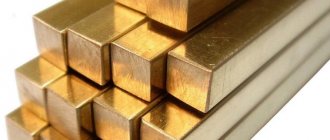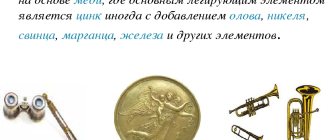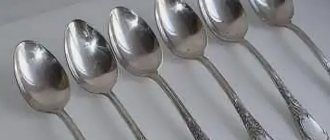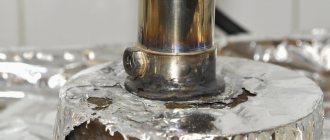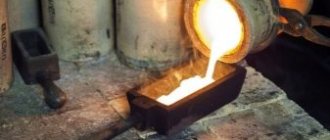Brass is an alloy based on copper and zinc. Various parts are made from it - bolts, screws, fasteners, parts for electrical tools, microcircuits and others. If necessary, brass can be melted in a special furnace to make the desired part from the melt. But what is the melting point of brass? Can it be melted at home? And what should a metallurgist remember when working with this alloy? These issues will be discussed in the article.
Physical features of melting homogeneous metals
Brass is a multicomponent alloy based on copper and zinc. It may also contain some other components - tin, lead, iron, nickel, manganese. Copper acts as the main substance, while additional components improve the physical properties of the material (strength, elasticity, electrical conductivity, corrosion potential). Melting of single-component and multi-component alloys has many differences. Therefore, before considering the issue of melting brass, it is necessary to consider the features of melting a homogeneous metal based on copper.
In physics, smelting is a procedure in which a solid metal turns into a liquid state. To melt copper, it must be heated to a temperature of 1.085 degrees Celsius. Typically, heating is carried out with a small temperature increase (~1150 degrees), since in practice copper alloys with the addition of alloying substances are often used, which increases the melting point.
Heating at the chemical-physical level
- Copper atoms are in a solid state before heating. On a chemical level, this means that they form a strong crystal lattice that is resistant to deformation and retains its shape upon impact.
- When heated, the potential energy of copper atoms increases, which leads to a deterioration in the strength of the crystalline structure of the material. However, the material retains its hardness because the crystal lattice is not destroyed (although it becomes less dense).
- When the temperature reaches 1.085 degrees, the copper atoms receive an excess amount of energy, which causes the crystal lattice of the alloy to disintegrate. At the physical level, the alloy changes from a solid to a liquid state.
- Now several situations are possible. Let's consider the first situation. If the material continues to be heated, it will retain its liquid state. At a temperature of 2.567 degrees, copper goes into a gaseous state (that is, the liquid begins to boil). In metallurgy, evaporation of copper is very rarely performed, since it has no practical benefit.
- But another situation is also possible. If liquid copper is not heated after melting, then the liquid will gradually begin to cool. This will cause the material to return to a solid form. At the chemical level, the crystal lattice will re-form.
One simple conclusion can be drawn from these theoretical calculations. For one-component compositions, the crystallization temperature and melting temperature are the same. In practice, it is simple to regulate the melting procedure - you just need to reduce or increase the temperature of the fire. During work, it is also necessary to monitor the distribution of fire over the entire area of the metal object. If the temperature distribution is uneven, some components will be in a liquid state, while others will be in a solid state.
Copper and its alloys as a source of non-ferrous secondary metal
Weighing “pure” metal and its alloys on the scale of profitability when handing over scrap metal, we can say that the cost of the former is one and a half to two times higher. However, the weight content of copper in metal structures is often inferior to its alloys.
Thus, copper alloys can be found among deteriorating plumbing products: water taps, valves, shower hoses and tubes. Many old lamps and door fittings are also made of copper alloys, but the top of the pedestal, in terms of weight content, is occupied by heating radiators.
You should look for copper directly among household appliances, preferably those that have already exhausted their service life:
tube TV – 1.5 kg;
Tube TV with copper
semiconductor TV receiver – 0.5 kg;
compression refrigerator - about a kilogram in the engine, the radiator tubes can contain the same amount;
electric motors - on average a kilogram per kilowatt of power;
Magnetic starters are undeservedly ignored, although the equipment, in addition to the windings, contains copper in the tires. A small metal content, less than a kilogram, will bring automobile starters and generators, chokes of fluorescent lamps, transformers, relays, refrigerator compressors
See the article - Where to look for copper scrap metal?
Physical features of melting multicomponent alloys
Multicomponent compositions consist of several elements. This imposes a number of features on the melting of such materials:
- Multicomponent alloys consist of several elements. Together they also form a strong crystal lattice. The properties of such a material are identical to one-component alloys, and sometimes can exceed them. Basic examples are higher strength, lower risk of corrosion, higher shelf life, and so on.
- When a multicomponent alloy is heated, the potential energy of individual atoms increases. But the crystal lattice retains its strength, so the substance retains its original shape.
- When the critical heating temperature is reached, the crystal lattice gradually disintegrates. But since the alloy contains atoms of different categories, the lattice disintegrates unevenly (different atoms have their own boiling point). At the physical level, such a substance will be a mixture of solid and liquid fragments.
- The temperature at which low-melting atoms begin to enter the liquid phase is called the solidus point. If you reduce the fuel supply, low-melting atoms will begin to form a crystal lattice again, which will lead to solidification of the alloy. For brass, the solidus point is 880 degrees Celsius (zinc is a more fusible material).
- The temperature at which all atoms begin to enter the liquid phase is called the liquidus point of the substance. The liquidus point indicates how hot a material must be heated to completely melt it. The dynamics here are standard - as the fire supply decreases, a gradual crystallization of molten atoms will occur. For brass, the liquidus point is 950 degrees Celsius.
What we didn't know about copper
One of the advantages of this amazing metal is that tools made from it do not produce sparks when struck. It is wise to use them where there is a risk of explosion.
Swedish scientists have come up with a way to bury radioactive waste. Now huge amounts of money are being spent on this. Or you can simply place radioactive trash in copper capsules with walls 5 centimeters thick. According to calculations, corrosion will destroy them no sooner than in half a million years.
Many people know that the Statue of Liberty (the one with the torch and the crown) is made of copper. Not entirely, of course, non-ferrous metal only on top, steel structures inside. There were rumors that it was made of Ural metal, but... It was officially recognized that it came from Norway.
Here is a case when a seemingly useful property of our hero became a disadvantage. A Norwegian cargo ship sank due to the copper ore it was carrying. Electrochemistry is to blame. Copper from the ore created a galvanic couple with the metal hull of the ship, the evaporation of sea water served as the electrolyte. The resulting current provoked such corrosion that it ate through the lining, and water poured into the holds.
For fashionistas and fashionistas
The secret of the “Gold Vision-3000” jeans is the copper biocorset. Copper threads, “built-in” into fashionable pants, help prevent vascular pathologies and stimulate the functioning of the pelvic organs. And they affect digestion, sexual function, hematopoiesis, reduce the harmful effects of household appliances, and the influence of electromagnetic fields.
Alloy smelting
From the previous calculation one can draw a complex conclusion about the smelting of brass. The main conclusion is that brass does not have a single melting temperature due to the composition of the alloy. The melting point of brass will be between 880 and 950 degrees Celsius (solidus and liquidus points). The metal needs to be heated in several stages - first, some components are straightened, so the main substance begins to melt. Crystallization of brass will also occur according to the same pattern - first the more fusible elements will solidify, and then the more refractory ones.
Some other features of brass smelting:
- The main types of brass are two-component alloys based on copper and zinc. It is for these alloys that the melting point of brass will be 880-950 degrees. However, there are also other brands of brass - silicon, multi-component and others. For these alloys, the solidus and liquidus points may deviate from the specified values (and the higher the content of alloying additives, the greater the deviation will be).
- The specific heat of fusion of brass is approximately 380 kilojoules of energy. In fact, this means that to heat 1 kilogram of brass by 1 degree, an energy of 380 kilojoules must be provided to the part. For more severe heating, the amount of supplied energy should be increased proportionally. In practice, most often the melting of brass is usually carried out in electric furnaces. Therefore, when selecting a heater, its power is important. In fact, it must be at least 25 kilowatts - otherwise the metallurgist will not be able to heat the alloy to the required temperature.
Application of copper:
- 1. Hydrogen
- 2. Helium
- 3. Lithium
- 4. Beryllium
- 5. Boron
- 6. Carbon
- 7. Nitrogen
- 8. Oxygen
- 9. Fluorine
- 10. Neon
- 11. Sodium
- 12. Magnesium
- 13. Aluminum
- 14. Silicon
- 15. Phosphorus
- 16. Sulfur
- 17. Chlorine
- 18. Argon
- 19. Potassium
- 20. Calcium
- 21. Scandium
- 22. Titan
- 23. Vanadium
- 24. Chrome
- 25. Manganese
- 26. Iron
- 27. Cobalt
- 28. Nickel
- 29. Copper
- 30. Zinc
- 31. Gallium
- 32. Germanium
- 33. Arsenic
- 34. Selenium
- 35. Bromine
- 36. Krypton
- 37. Rubidium
- 38. Strontium
- 39. Yttrium
- 40. Zirconium
- 41. Niobium
- 42. Molybdenum
- 43. Technetium
- 44. Ruthenium
- 45. Rhodium
- 46. Palladium
- 47. Silver
- 48. Cadmium
- 49. Indium
- 50. Tin
- 51. Antimony
- 52. Tellurium
- 53. Iodine
- 54. Xenon
- 55. Cesium
- 56. Barium
- 57. Lanthanum
- 58. Cerium
- 59. Praseodymium
- 60. Neodymium
- 61. Promethium
- 62. Samaria
- 63. Europium
- 64. Gadolinium
- 65. Terbium
- 66. Dysprosium
- 67. Holmium
- 68. Erbium
- 69. Thulium
- 70. Ytterbium
- 71. Lutetium
- 72. Hafnium
- 73. Tantalum
- 74. Tungsten
- 75. Rhenium
- 76. Osmium
- 77. Iridium
- 78. Platinum
- 79. Gold
- 80. Mercury
- 81. Thallium
- 82. Lead
- 83. Bismuth
- 84. Polonium
- 85. Astatine
- 86. Radon
- 87. Francium
- 88. Radium
- 89. Actinium
- 90. Thorium
- 91. Protactinium
- 92. Uranus
- 93. Neptunium
- 94. Plutonium
- 95. Americium
- 96. Curium
- 97. Berkeley
- 98. California
- 99. Einsteinium
- 100. Fermium
- 101. Mendeleevium
- 102. Nobelium
- 103. Lawrence
- 104. Rutherfordium
- 105. Dubniy
- 106. Seaborgium
- 107. Borius
- 108. Hassiy
- 109. Meitnerium
- 110. Darmstadt
- 111. X-ray
- 112. Copernicius
- 113. Nihonium
- 114. Flerovium
- 115. Moskovy
- 116. Livermorium
- 117. Tennesseen
- 118. Oganesson
- https://en.wikipedia.org/wiki/Copper
- https://de.wikipedia.org/wiki/Kupfer
- https://ru.wikipedia.org/wiki/Copper
- https://chemister.ru/Database/properties.php?dbid=1&id=239
- https://chemicalstudy.ru/med-svoystva-atoma-himicheskie-i-fizicheskie-svoystva/
Note: Photo https://www.pexels.com, https://pixabay.com
Site Map
copper atomic mass oxidation state valence density melting boiling point physical chemical properties structure thermal conductivity electrical conductivity crystal lattice atom draw the structure number of protons in the nucleus structure of electron shells electronic formula configuration scheme of the structure of the electron shell charge of the nucleus composition mass orbit levels model radius electron energy transition speed spectrum wavelength molecular mass volume of an atom electronic formulas how many atoms are in a copper molecule how many electrons are in an atom properties metallic nonmetallic thermodynamic
Demand factor 1,005
How is brass melted in metallurgical plants?
The alloy is usually melted in metallurgical plants, since favorable conditions for remelting are created there. During factory melting, the material retains all its physical properties - strength, electrical conductivity, retention of shape during deformation, and so on. The technology for remelting brass at a factory depends on what category of brass the material belongs to. Two-component alloys (with added zinc) are usually melted in induction furnaces that have quartz-lined walls. This coating minimizes overheating of the furnace and also protects the walls from deformation and cracking.
Double brasses melt at relatively low temperatures (the liquidus point for them is in the region of 910-930 degrees Celsius). Therefore, there is no point in melting dual alloys in powerful electric arc furnaces. For the melt, it is recommended to use a charcoal-based protective layer. It is also recommended to introduce a small amount of cryolite into the melt (about 0.01-0.1%) - this helps reduce metal defects during smelting. Instead of charcoal, you can use a flux consisting of glass and spar in a 1 to 1 ratio.
To remelt two-component brass, you must first melt the copper and then the zinc. To melt metal, you need to heat it to a temperature of about 1000-1100 degrees. After this, zinc and alloying additives, if available, should be added. Please note that there is no need to deoxidize brass, since zinc performs this function perfectly.
Complex non-siliceous brass
Melted according to a similar algorithm. These alloys contain zinc in small quantities. Therefore, such a metal must be deoxidized in order to preserve all its beneficial physical properties. Phosphorus is suitable for deoxidation, although other deoxidizers can be used. When melting, complex brass often produces large debris fractions - to get rid of them, you should perform manganese refining or filtration.
Complex silicon brasses
They have complex crystallization dynamics, which is explained by the presence of silicon and aluminum additives in the alloy composition. Due to the presence of these components, the alloy has an increased tendency to absorb atmospheric hydrogen at high temperatures (more than 1000 degrees).
When the alloy is heated to temperatures above 1100 degrees, batch releases of dissolved carbon may occur, which can lead to the formation of “blisters” on the alloy after it hardens. Therefore, approach the remelting of silicon steels responsibly. To avoid the release of dissolved carbon, smelting should be carried out in an acidic environment. Saturating the air with an acid flux based on sodium carbonate, calcium fluoride and silicon oxide works well. It is important to monitor the heating temperature, since the protective properties of the gas oxidizer noticeably decrease when the temperature reaches 1100 degrees.
After melting all components in a protective environment, it is necessary to perform a mandatory check of the metal for all main indicators (fracture, saturation, presence of contaminants, and so on).
Manufacturing methods and characteristics
Physical data
The characteristics of the alloy are determined by its chemical composition and can vary within certain limits. Bronze is less susceptible to corrosion and provides better metal-to-metal glide than brass. It has higher strength and is less susceptible to atmospheric influences (water and air) and better resists salts and organic acids. It is easy to machine, it can be soldered and fastened by welding. Some physical characteristics of bronze:
- specific gravity from 7.8 to 8.7 tons/cu.m. meter;
- melting point of bronze – melts when heated from 930 to 1140 degrees;
- color changes from red - the color of copper, to white - the color of tin;
- wear resistance and good sliding on metal determine the scope of application as sliding bearings; they work well in any temperature conditions;
- There is high electrical conductivity and heat transfer, resistance to steam, which contributes to the manufacture of parts for equipment operating in extreme situations.
Article on the topic: How to use a portable gas stove
How to make bronze
Melting and mixing copper melts and additives of different metals, which make it possible to give the alloy certain required characteristics, leads to the production of an alloy metal such as bronze. The manufacturing process involves electric induction furnaces and crucible forges; with their help, any alloys with copper can be produced.
Melting is carried out with flux additives, and the initial raw material for smelting can be either copper ore or copper scrap. Typically, scrap copper is added to the melt along with the filler metal during the smelting process. When smelting only copper ore, the following operations are performed:
- the furnace is heated, copper ore with flux additives is placed in it, and melted at a temperature of about 1200 degrees;
- a chemical oxidizer is added - phosphorous copper, half could be loaded as part of the flux, and the rest is additionally loaded with a ladle;
- during melting, filler metals are added to the deoxidized molten copper, preheated to one hundred degrees;
- After settling the melt for half an hour, the floating slag is removed from its surface, and the resulting alloy is distributed into molds.
When using scrap copper, the procedure for making bronze is the same.
Is it possible to melt brass at home?
It is not recommended to melt the alloy at home.
Main problems:
- Temperature errors. To completely melt copper and zinc, you will have to bring the object to a temperature of at least 950 degrees. Making such a stove in practice is not very easy, since it will require fireproof parts. You will also have to maintain a high temperature for a long time, which will lead to high fuel consumption.
- Corrosion and oxide formation. When a brass part melts, copper and zinc particles will begin to actively react with air. This can lead to the formation of complex compounds. Which, in addition to copper and zinc, include oxygen, nitrogen, carbon, and other substances. These additives significantly increase the fragility of the smelted part, which can render it useless.
That is why it is recommended to melt brass in special factories or factories where the necessary conditions are created (temperature, protective environment, and so on). However, in practice, many people still melt brass at home. As a result of home casting, you can get a part of average quality. Such parts are not recommended for use in hazardous areas (automotive parts, electrical equipment, fittings on large buildings).
Adviсe
However, such parts can be used in the household (for example, you can make brass bolts, screws or corners for fastening interior objects). To smelt brass at home, you need to make a furnace that can withstand temperatures above 1000 degrees Celsius (the standard melting temperature at home is 880-950 degrees). To strengthen the stove, it is recommended to install a metal frame on the stove (the optimal alloy is alloy steel).
You will also need to make or buy a crucible in which the metal will be smelted. The crucible should be made of graphite or fireclay bricks. These materials do not melt at high temperatures (the melt temperature of brass at home is 950 degrees). Also, these materials do not crumble and do not come into contact with air, which has a good effect on the quality of smelting. It is recommended to make such a stove from refractory bricks, and a heat-resistant mortar should be used to connect individual elements to each other.
You can use charcoal for heating. The main advantage of coal is that its use minimizes the risk of the formation of harmful additives that worsen the quality of the smelted part. Unfortunately, using coal to melt brass is a very expensive undertaking. Therefore, electric inductor heaters should be used for remelting. The minimum current power should be 25 kilowatts, otherwise it will not be possible to obtain the required temperature to melt the brass.
The melting procedure should be carried out in a well-ventilated area. The reason is that molten zinc will react with oxygen, resulting in the formation of oxides. Zinc oxides in large quantities can be dangerous. For melting, you will also need tools - gloves, a powerful mask and tongs for moving the crucible with molten metal. It is recommended to buy pliers from tool steel, since such steel is resistant to high temperatures.
Safety precautions
To carry out all operations with metals heated to very high temperatures, it is necessary to take care of your safety and minimize the impact of the process on health. It is worth remembering what metals brass is made of, at what temperature a particular sample melts and how it is achieved. Here are some tips:
- Use protective gloves and clothing made from materials that are difficult to burn - wool, cotton and others. You should not use synthetic clothing, as it can catch fire very quickly.
- Take care to protect your eyes and face with glasses and masks, as an accidental drop of molten metal can cost you your eyesight or cause a serious burn to your facial skin.
- Casting must be carried out in a place with sufficient ventilation, as during the casting process substances are released that, if they acquire sufficient concentration, can cause great harm to your health.
- In order to minimize the risks of arson or accidental ignition of nearby objects, you can cover the surface on which the stove will be located with an asbestos sheet. Again, do not forget about good ventilation.
By following these guidelines, you can safely and effectively handle hot or molten metals without fear of harm to yourself or others.
Biological role of copper
The body of a healthy person should contain at least 100 g of the microelement copper. It performs an important biological role:
- Takes part in the absorption and production of iron.
- A component of most enzymes involved in redox processes.
- Provides filling of the brain and tissues with the necessary amount of oxygen.
- Without the element, normal formation of tendons, skeleton, muscles, and cartilage is impossible.
- Promotes the formation of red blood cells and hemoglobin.
- In childhood, it promotes bone growth.
- Deficiency of the substance leads to rheumatoid arthritis, autoimmune diseases, inflammatory processes in bones and tissues.
- Makes the walls of blood vessels strong and elastic.
- Maintains skin elasticity.
The substance got its name from the Greek word “Cyprus”
Its importance was established in 1928, as a result of numerous scientific studies
Copper. Description
Copper. It is an essential mineral for the human body that is found naturally in foods and is also available as dietary supplements.
Copper is a cofactor for several enzymes (known as cuproenzymes) involved in energy production in the human body, iron metabolism, neuropeptide activation, connective tissue and neurotransmitter synthesis.
One of the common cuproenzymes is ceruloplasmin (CP), which is involved in the process of iron metabolism and accounts for more than 95% of the total amount of copper in the plasma of a healthy person.
Copper is also involved in many physiological processes, such as:
- angiogenesis (the process of formation of new blood vessels in organs or tissues, during which a reorganization of the primary capillary network occurs, which is reduced to a simpler and clearer system of capillaries, arteries and veins.)
- neurohormonal homeostasis (self-regulation)
- regulation of gene expression (implementation of the information stored in genes, that is, the synthesis of RNA and proteins. In other words, regulation of gene activity)
- brain development
- pigmentation and immune system functioning
In addition, protection against oxidative damage depends mainly on copper-containing superoxide dismutases.
Quite a large amount of both plant and animal foods contain copper. The average person's dietary copper intake is approximately 1400 mcg/day (men) and 1100 mcg/day (women). Next, almost all of the consumed copper is absorbed in the upper small intestine. Approximately two-thirds of all copper reserves in the body are concentrated in the skeleton and muscles.
Typically, the body accumulates a small amount of copper; in an adult, the total amount of this substance in the body does not exceed 50-120 mg.
Most copper is excreted from the body in bile, and a small amount in urine. Total fecal losses of biliary copper and unabsorbed dietary copper are approximately 1 mg/day.
Copper levels in the body are homeostatically maintained by the absorption of copper from the intestines and the release of copper into bile by the liver to reduce the risks of copper deficiency and toxicity.
Copper status is not routinely assessed in clinical practice, and no biomarkers have been identified that accurately and reliably assess copper status. In human studies, it is common to measure plasma copper and cuproenzyme activity because people with known copper deficiency often have low blood copper and cuproenzyme levels. However, plasma CP levels and copper levels can be influenced by other factors, such as estrogen status, pregnancy, infections, inflammation, and some types of cancer.
Normal serum concentrations are 10–25 µmol/liter (63.5–158.9 µg/dL) for copper and 180–400 mg/L for CP.
What is thermal conductivity
This term means the ability of various materials to exchange energy , which in this case is represented by heat. In this case, energy transfer passes from the hotter part to the colder part and occurs due to:
- Molecules
- Atoms.
- Electrons and other particles of the metal structure.
The thermal conductivity of stainless steel will differ significantly from that of another metal - for example, the thermal conductivity of copper will be different than that of steel.
To indicate this indicator, a special value is used, called the thermal conductivity coefficient. It is characterized by the amount of heat that can pass through a material in a certain unit of time.
Indicators for steel
Thermal conductivity can vary significantly depending on the chemical composition of the metal. The coefficient of this value will be different for steel and copper. In addition, with an increase or decrease in carbon concentration, the indicator under consideration also changes.
There are other features of thermal conductivity:
- For steel that does not have impurities, the value is 70 W/(m* K).
- Carbon and high-alloy steels have much lower conductivity. Due to an increase in the concentration of impurities, it is significantly reduced.
- The thermal effect itself can also affect the structure of the metal. As a rule, after heating, the structure changes its conductivity value, which is associated with a change in the crystal lattice.


